|
 Pholiota aurivella Pholiota aurivella
SynonymsAgaricus aurivellus
Agaricus adiposus
Pholiota adiposa
BiostatusPresent in region - Indigenous. Non endemic
Images (click to enlarge)
Caption: 3-Pholiota aurivella [Pholiota adiposa sensu Massee]: a. spores; b. chrysocystidia. | 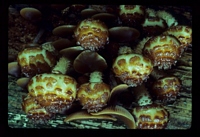
Owner: G.L. Barron | 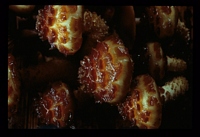
Owner: G.L. Barron | 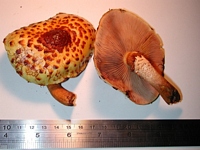
Caption: fruitbody
Owner: J.A. Cooper | 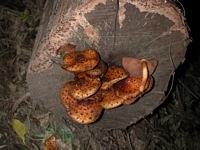
Caption: fruitbody
Owner: J.A. Cooper | 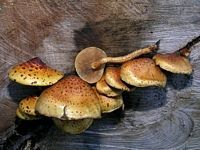
Owner: J.A. Cooper |
Article: Massee, G.E. (1899) [1898]. The fungus flora of New Zealand. Transactions and Proceedings of the New Zealand Institute 31: 282–349 Wellington:.
Description: Pileus convex, obtuse, then expanding, glutinous, yellow,. with superficial concentrically
arranged seceding darker squarrose scales, 5-12 cm. across; flesh whitish, compact at the
disc; gills adnate, 6-8 mm. broad, yellow, then rusty-orange; spores elliptical, rusty-orange, 7
x 3 µ; stem 7-12 cm. long, up to 2 cm. thick, base somewhat bulbous, remainder more orless
equal throughout, yellow, ornamented with concentrically arranged rusty-orange evanescent
scales up to the superior, floccose, radiating ring, stuffed.
Habitat: On decaying parts of trees.
Distribution: Cape Turnagain, Northern Island, New Zealand. Europe, United
States.
Notes: A very showy fungus when.well grown. Usually caespitose, and forming large clusters.
Distinguished by the glutinous. pileus and stem, both of which are at first ornamented with
rusty-orange or ferruginous squarrose or spreading scales. The scales appear eventually to
deliquesce in the gluten, which is washed away in rainy weather, leaving the .pileus and stem
naked. In dry weather the pileus is shiny, due to the dried gluten. Poisonous.
Article: Horak, E. (1971). A contribution towards the revision of the Agaricales (Fungi) from New Zealand. New Zealand Journal of Botany 9(3): 403-462 (http://www.rsnz.org/publish/abstracts.php).
Notes: Fig. 1 Microscopical characteristics of the preserved material (COLENSO 368) agree closely
with those of Pholiota aurivella (Fr.) Kummer. I am inclined to regard this fungus as an
adventitious species.
|